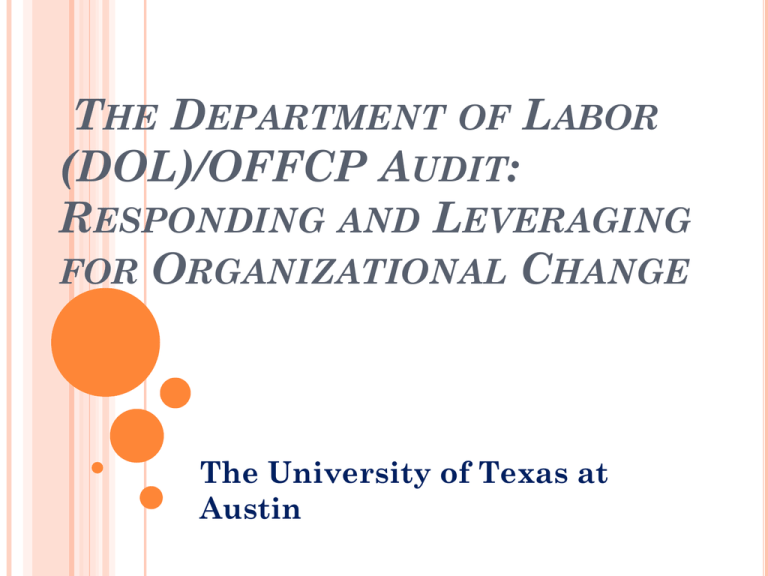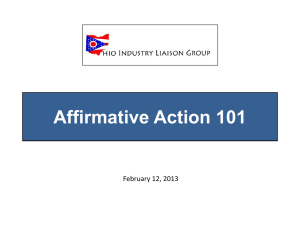
THE DEPARTMENT OF LABOR
(DOL)/OFFCP AUDIT:
RESPONDING AND LEVERAGING
FOR ORGANIZATIONAL CHANGE
The University of Texas at
Austin
LET’S START AT THE BEGINNING
Executive Order 11246, signed by President
Lyndon B. Johnson on September 24, 1965 required
Equal Employment Opportunity. Amended in 1967.
The term Equal Opportunity Employment originated
here.
Through this executive order, President Lyndon B.
Johnson gave the responsibility of enforcing parts of
the non-discrimination in contracts to the
Department of Labor. The Office of Federal Contract
Compliance Programs (OFCCP) was created.
Higher Education came to OFCCP in 1979 from
HEW’s Office of Civil Rights.
BACKGROUND – FEDERAL CONTRACTOR
OFCCP administers and enforces Executive
Order 11246, as amended, which prohibits
federal contractors and federally-assisted
construction contractors and subcontractors, who
do over $10,000 in Government business in one
year from discriminating in employment
decisions on the basis of race, color, religion,
sex, or national origin.
The Executive Order also requires Government
contractors to take affirmative action to insure
that equal opportunity is provided in all aspects
of their employment.
AFFIRMATIVE ACTION
REQUIREMENTS
Each Government contractor with 50 or more employees
and $50,000 or more in government contracts is required to
develop a written affirmative action program (AAP) for
each of its establishments.
A written affirmative action program helps the contractor
identify and analyze potential problems in the participation
and utilization of women and minorities in the contractor's
workforce.
If there are problems, the contractor will specify in its AAP
the specific procedures it will follow and the good faith
efforts it will make to provide equal employment
opportunity.
Expanded efforts in outreach, recruitment, training and
other areas are some of the affirmative steps contractors
can take to help members of the protected groups compete
for jobs on equal footing with other applicants and
employees.
ENFORCEMENT AND COMPLIANCE
Compliance Reviews
OFCCP conducts compliance reviews to investigate
the employment practices of Government contractors.
During a compliance review, a compliance officer
examines the contractor's affirmative action program;
checks personnel, payroll, and other employment
records; interviews employees and company officials;
and investigates virtually all aspects of employment
in the company.
The investigator also checks to see whether the
contractor is making special efforts to achieve equal
opportunity through affirmative action. If problems
are discovered, OFCCP will recommend corrective
action and suggest ways to achieve equal employment
opportunity.
HIGHER EDUCATION AND AUDITS
OFCCP doesn’t like higher ed– we are weird
OFCCP identifies industries to audit
OFCCP uses EEO-1 Reports to audit
Won’t tell you how you were selected
Will give you 30 days to respond to their letter,
which includes 11 items to provide
Items may be found on the internet or contact me
directly
THINGS REQUESTED
Job Groups
Utilization Analysis
Placement Goals, where appropriate
Preceding Year’s Goals
Data: applicants to hires; promotions;
terminations
Annualized Compensation: salary, race, gender,
job title
UT AUSTIN’S RECENT EXPERIENCE
Notice received fall 2006; received extension
Data submitted November 2006
April 2009, letter indicating severe
compensation concerns for faculty and staff
New data set requested and submitted May 2009
– liability for two years
BECAME PROACTIVE
April 2010 heard again on 5/09 data set:
Now only three titles of concern
OFCCP ANALYSIS
Three-tiered investigation approach
Tier 1: look for 2% difference in average salary between
whites and people of color, between men and women across
the organization
Tier 2: cluster employees across the institution into groups
of at least 30 with at least 5 from each comparison group
based on job title and pay from high to low pay
For each cluster conduct a regression analysis to assess
statistically significant differences in pay between comparison
groups
Tier 3: create Similarly Situated Employee Groups (SSEG)
and construct regression analyses for each group to
determine if there are statistically significant differences in
pay between comparison groups
You get to define your SSEGs
UT Austin faculty were tenured, tenure track, off track,
dept., college
UT Austin staff were by job title, dept., college/unit
PROACTIVE APPROACH
We started to anticipate what OFCCP would
find, based on 2009 data set submission.
John Moore’s group began to run stats looking for
disparities by SSEGs
This is what you should be doing on a regular
basis but certainly do it when your data is
requested. Don’t wait for them to tell you there
are problems – ANTICIPATE!!
DOWN TO SPECIFICS
In April 2010, now at the area office, apology for
time delay
Identified three titles (i.e., SSEGs):
Associate Professors in college A (n=37)
Postdocs in college B (n=173)
Minorities (10) paid more than Whites (27)
Minorities (93) paid less than Whites (80)
Administrative Assistants in college B (n=33)
Men (10) paid more than women (23)
ADMINISTRATIVE ASSISTANTS
Using multiple regression analysis, salaries
of admin assistants were examined for
differences between males and
females. Independent variables included gender,
full time or part time status, and months
of service. Gender was insignificant
(t = -1.60, p = .1229) while full time/ part time
status did affect salary.
ADMINISTRATIVE ASSISTANTS CONT.
Remember asked for annualized salaries. But we
found that some of the administrative assistants
were actually paid hourly/part time.
We found that some were located outside of
Austin, where the salaries are lower.
We found consistency in salaries at the
departmental level. Some departments are richer
than others.
POSTDOCTORAL FELLOWS
Using multiple regression analysis, salaries of
postdocs were examined for differences between
minorities and non-minorities. Independent variables
included minority/non-minority and academic
discipline, reflected in the department affiliation.
Minority/non-minority was marginally significant (t =
1.93, p = .056). As noted above, postdoc positions are
highly individualized, and the individual
characteristics and requirements of each position
contribute to the actual salaries. However, that
individuality also makes it impossible to conduct only
statistical analyses. Accordingly, differences in salary
are due not only to the discipline one works in but
also to the unique differences in the individual
positions and matching those to a relatively small
pool of qualified individuals.
POSTDOCS CONTINUED
Compensation rates were determined by project
funding. Project funding considers many factors:
experience of the Postdoctoral Fellow, academic
credentials, skill set and contribution to the
project, project budget, grant compensation
guidelines, salaries of others on the project, etc.
Race is never a factor in the compensation of a
Postdoctoral Fellow.
FACULTY EXAMPLE
Nonminority Associate Professor is paid, on
average, $51,500 with 37 years in current rank
and 41 years with the University, while a
Hispanic Associate Professor with only three
years in current rank and nine with the
University is paid $81,011.
How would you explain this?
What would you do?
What variables do you have quantified to use
statistically?
FACULTY CONTINUED
Met with department chairs for explanation of
salaries.
Newly hired often command higher salaries – more
market driven
Previous example proved to be someone who retired
some years prior and taught a class or two as
requested
Some no longer employed
Some were acknowledged to be nonproductive
scholars who did not seek promotion
STATISTICS GO ONLY SO FAR
Once April 2010 identified three titles, John’s
group did their work using regression models and
quantifiable variables to explain the statistical
differences.
But stats only go so far, so I had to individually
look at those 243 individuals OFCCP was
interested in. Think Tier 4 analysis.
IT TAKES A VILLAGE
UT Austin had to utilize the services of many
departments to respond to this audit.
HRS and IMA created data for their people. HRS
handled stats for staff and faculty. Helps to have
some statistical expertise, internal or external,
because compensation equity analysis is
statistical.
We anticipated problems but in the end, it took
an individualized analysis of each of the 243
individuals to explain their compensation.
ME
I knew the institution did not determine
someone’s salary based on the way they look.
Ultimately, it took someone who had survived
audits before and who had a working relationship
with OFCCP to make this work.
You have to explain tenure and merit increases
for faculty. You have to explain how staff salaries
are set.
You have to be respectful but tenacious in
defending your institution.
UT IN A FISHBOWL
Keep legal informed but don’t let them take over
Keep public affairs informed but at a distance
Keep your boss informed
Get advice from others who have gone through it
Identify needed expertise to argue your case
Use the experience to advocate for resources to be
prepared for the next audit
QUESTIONS??
LEVERAGING COMPLIANCE FOR
IMPROVED ORGANIZATIONAL
STRUCTURE
UT Austin
Director Series restructuring project
A & P PROJECT OVERVIEW
THEHRA Presentation Draft
The purpose of Administrative and Professional (A&P)
job restructuring project is to align those jobs
designated as A & P with established criteria and
restructure others in order to achieve greater definition
in work content, compensation and compliance with
policy.
The project was initiated by the Human Resources
Consortium with a subcommittee that provides
research, data gathering, analysis and formulates
recommendations.
24
A & P PROJECT GOALS
Better align pay
with jobs by
establishing ranges
and salary grades
for more titles—
both A&P and
classified
Better understand
the work content by
providing job
descriptions for an
increased number
of job
classifications.
THEHRA Presentation Draft
Align job titles and the
incumbent employees in
them into the proper
pay type in accordance
with policy and
statutes.
25
A & P PROJECT: PHASE I—DIRECTOR
TITLES
As shown in the graphic on the next page, the Director
series titles no longer reflect a coherent organizational
title structure as indicated by pay.
Therefore as a first step, the project focused on the
Director title (0379 and 0382) plus the many related
titles including Executive Director, Assistant /Associate
Director, “Director of xxxx” and others.
THEHRA Presentation Draft
26
$400,000
Min
Avg
Max
Spread
$350,000
$300,000
THEHRA Presentation Draft
$250,000
$209,210
$200,000
$158,058
$153,333
$150,000
$148,983
$138,016
$123,370
$108,689
$115,894
$100,000
$61,800.00
$93,220
$99,292
$96,597
$55,500
$60,000
$55,000
$64,890
$44,594
Per Cent
468%
$0
375%
260%
299%
251%
82%
281%
0%
212%
289%
$90,000
$79,929
$70,000
$61,234
$50,000
$118,052
$102,310
$95,973 $93,250
$73,000 $74,323
$68,935
$61,530
$57,387
$43,260
$43,000
300%
67%
71%
208%
0%
0%
84%
37%
27
DIRECTOR TITLES CURRENT PICTURE
Additionally, the previous slide shows that the
distribution of pay for Assistant and Associate Directors
does not relate to the Director employee pay
distribution in a way that is meaningful.
THEHRA Presentation Draft
28
DIRECTOR TITLES CURRENT PICTURE
Inequities are created where jobs with lower attributes have
higher titles and vice versa.
Implications for compliance (fair pay and “glass ceiling”
analysis).
Managing the workforce (relating contribution and title
across campus jobs).
THEHRA Presentation Draft
The use of Director, Assistant and Associate Director
titles across campus evolved in scope, function and
compensation so that there is not a valid and viable
hierarchy that is represented using the existing title
structure.
29
DIRECTOR TITLES: RECOMMENDATION
Establishing structural attributes
Restructure existing Assistant Director, Associate Director,
Risk Management
At Will status
THEHRA Presentation Draft
Director and Executive Director titles into a 5-tier Director
structure with appropriate relative attributes in:
Scope—span of control
Organizational (reports to)
Administrative Officer designation
Competency
Compensation
30
PROPOSED DIRECTOR STRUCTURE
Proposed is a 5-tier Director title structure to provide
A meaningful hierarchy of these jobs based on key attributes
in scope, function, competency requirements and
compensation.
Equity based on relative contribution and worth of the titles
across campus.
Improve our ability to manage the workforce and better
understand work content.
THEHRA Presentation Draft
31
NEW DIRECTOR SERIES
Pay Plan
Director I
Fiscal Management
Risk Impact
Outlook
Director IV
Director V
Coordinator
Coordinator
Coordinator
Coordinator
D6
D7
D8
D9
D10
Another director
Another director
Another Director
AVP
VP/Dean or Above
AVP
AVP
AVP
VP or Dean
Asst/Assoc Dean
Asst/Assoc Dean
VP or Dean
1 or More Manager
Multiple managers
Another Director
Directors
Directors
May be indiv contrib
May be indiv contrib
2-7 Prof Staff
> 7 Prof Staff
> 20 Total Staff
$0-99K
$0-99K
$1-5M
$5-10M
>$10M
Department Risk
Department Risk
Department Risk
Major Funding
Major Funding
Unit/Sub Unit
Unit
Department
Multiple Departments
Enterprise
ORP
No
No
Yes
Yes
Yes
AO
No
No
Yes
Yes
Yes
Min
Mid
Max
Salary Grade*
D6
$45000
$87,989
$109,966
D7
$75,987
$101,179
$126,496
D8
$87,282
$116,356
$145,470
D9
$100,374
$133,797
$167,290
D 10
$125,468
$167,247
> $209133
THEHRA Presentation Draft
Scope (Span of Control)
Director III
Coordinator
Salary Grade:
Reports To:
Director II
32
PRESENTERS
Linda Millstone
Associate Vice President for Institutional Equity
LindaM@austin.utexas.edu
John Moore
Director, Workforce Planning
john.moore@austin.utexas.edu
Rich Burns
Project Consultant
rich.burns@austin.utexas.edu












